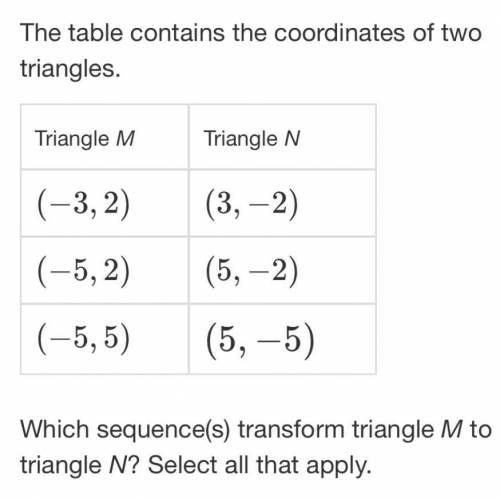A
a 180° clockwise rotation about the origin
B
a 270° counterclockwise rotation...

Mathematics, 14.12.2021 21:10 Diego5140
A
a 180° clockwise rotation about the origin
B
a 270° counterclockwise rotation about the origin
C
a reflection over the y-axis, then a reflection over the x-axis
D
a reflection over the x-axis, then a reflection over the y-axis
E
a reflection over the y-axis and then a 90° clockwise rotation about the origin
F
a 90° counterclockwise rotation about the origin, then a reflection over the y-axis


Answers: 3


Another question on Mathematics

Mathematics, 21.06.2019 19:00
The graph shows the charges for a health club in a month. make a function table for the input-output values. writes an equation that can be used to find the total charge y for the number of x classes
Answers: 2

Mathematics, 22.06.2019 01:00
Mia’s gross pay is 2953 her deductions total 724.15 what percent if her gross pay is take-home pay
Answers: 2

Mathematics, 22.06.2019 03:00
Jackson earns $25 per hour as a tutor at the college library. he set a weekly spending budget of $130 each week and puts the remaining money in his savings account. how many hours must he work this week to have at least an extra $50 to put in his savings account
Answers: 2

Mathematics, 22.06.2019 03:00
In this problem, we explore the effect on the standard deviation of multiplying each data value in a data set by the same constant. consider the data set 14, 6, 8, 15, 15. (a) use the defining formula, the computation formula, or a calculator to compute s. (round your answer to one decimal place.) s = 4.28 (b) multiply each data value by 3 to obtain the new data set 42, 18, 24, 45, 45. compute s. (round your answer to one decimal place.) s = 12.83 (c) compare the results of parts (a) and (b). in general, how does the standard deviation change if each data value is multiplied by a constant c? multiplying each data value by the same constant c results in the standard deviation remaining the same. multiplying each data value by the same constant c results in the standard deviation being |c| times as large. multiplying each data value by the same constant c results in the standard deviation increasing by c units. multiplying each data value by the same constant c results in the standard deviation being |c| times smaller. (d) you recorded the weekly distances you bicycled in miles and computed the standard deviation to be s = 3.8 miles. your friend wants to know the standard deviation in kilometers. do you need to redo all the calculations? yes no given 1 mile ≠1.6 kilometers, what is the standard deviation in kilometers? (enter your answer to two decimal places.)
Answers: 1
You know the right answer?
Questions



Mathematics, 13.05.2021 20:00






Mathematics, 13.05.2021 20:00


Mathematics, 13.05.2021 20:00

Mathematics, 13.05.2021 20:00




Biology, 13.05.2021 20:00


English, 13.05.2021 20:00


Mathematics, 13.05.2021 20:00




